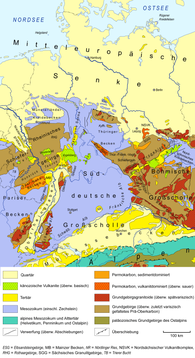bay
A bay is a geographical object enclosed on three sides by higher terrain on a local or regional scale. Usually the term is used for terrain below a body of water , so that the bay expresses itself in the form of an approximately arc-like receding of the shoreline. On dry land, this is also used to describe areas that are surrounded by a mountain front that recedes almost like an arch. In the case of water, the bay is the counterpart to the headland .
The size of water bays can be a few meters or several hundred kilometers in width or extent. A large bay is also known as a gulf or (less often) as a bay . A small water bay is also known as Anse .
Bays in waters
A bay lying in a body of water is a section of a lake or sea that protrudes into the shore or coastal area as a “bulge” . On flat coasts , small bays are often separated from the open sea by spits . On the southern coast of the Baltic Sea, such cut-off bays are also called lagoons . Sea bays whose opening to the open sea is less than 24 nautical miles wide (Art. 10 UNCLOS ) count as inland waters under international law . Under a minimum width of 3.5 nautical miles and a certain minimum depth, bulges in the sea may not be referred to legally under international law as a bay, but as a fjord or fjord .
In larger bays there can be islands , peninsulas or a Wadden Sea . The bottom is mostly flat, but it can also be shaped as a small basin .
Examples
- Baffin Bay (northwestern marginal sea of the Atlantic; North America)
- Hudson Bay (in the Canadian Shield ; North America)
-
German Bight (main bay or largest bay on the Danish-German-Dutch coast; Central Europe) :
-
Helgoland Bay (part of the German Bight ) :
- Meldorfer Bucht (part of the Helgoland Bay )
- Dollart (part of the German Bight )
-
Helgoland Bay (part of the German Bight ) :
-
German Baltic Sea coast; Central Europe :
- Geltinger Bay (part of the Flensburg Fjord in front of Schleswig-Holstein )
-
Bay of Kiel (main bay off the east coast of Schleswig-Holstein) :
- Eckernförde Bay (part of the Kiel Bay )
- Hohwachter Bay (part of the Kiel Bay )
- Kiel Fjord (part of the Kiel Bay )
-
Mecklenburg Bay (main bay between Schleswig-Holstein and Mecklenburg-Western Pomerania ) :
-
Bay of Lübeck (part of the Bay of Mecklenburg ) :
- Wismar Bay - (part of the Bay of
-
Bay of Lübeck (part of the Bay of Mecklenburg ) :
- Pomeranian Bay (main bay Mecklenburg-Western Pomerania)
Bays on land
Bays on land areas are approximately arch-shaped extensions of lowlands (then also referred to as lowland bays ) or at least areas with less relief that protrude into an adjacent mountain range or an area with more relief. As a rule, these are marginal subsidence areas of the corresponding plateaus, which can often be demarcated from the neighboring high areas in geological maps by their structure from younger layers (e.g. Paleozoic basement vs. Mesozoic table top mountains or Mesozoic table top mountains vs. Quaternary ) .
Examples
- Westphalian Bight , lowland bay between the northern edge of the Rhenish Slate Mountains and the Lower Saxony mountains ( North Rhine-Westphalia , Germany , Central Europe ), foothills of the North German Plain , morphological expression of the Münsterland chalk basin
- Cologne Bay , lowland bay on the northern edge of the Rhenish Slate Mountains (North Rhine-Westphalia, Germany, Central Europe), foothills of the North German Plain, morphological expression of the Lower Rhine Rift
- Korbacher Bucht , eastern edge of the Rhenish Slate Mountains north of the Kellerwald , ( Hesse , Germany, Central Europe), foothills of the Hessian Depression
- Medebacher Bucht , very small, relatively high-lying low mountain range on the eastern edge of the Rothaargebirge (North Rhine-Westphalia, Germany, Central Europe), foothills of the Hessian valley
- Frankenberger Bucht , eastern edge of the Rhenish Slate Mountains south of the Kellerwald , (Hesse, Germany, Central Europe), foothills of the Hessian Depression
- Leipzig lowland bay , lowland bay on the northern edge of the low mountain range in Thuringia , Saxony and Saxony-Anhalt (Germany, Central Europe), foothills of the North German lowlands
- Backnanger Bay , small-scale depression on the western edge of the sandstone keuper plateau of the Süddeutsche Tafel ( Baden-Württemberg , Germany, Central Europe), foothills of the Neckar basin
Related topics

- A bay that was formed by a glacier is called, depending on how it was formed , a fjord , fjärd or fjord .
- Bays that emerged from river valleys are called ria .
- In Italy there are so-called calettas , these are small bays or harbors that can be found mainly in the south along the coasts.
See also
Individual evidence
- ↑ Duden online: Anse
- ^ Erwin Beckert, Gerhard Breuer: Public Maritime Law. de Gruyter, Berlin / New York 1991, ISBN 3-11-009655-2 .


